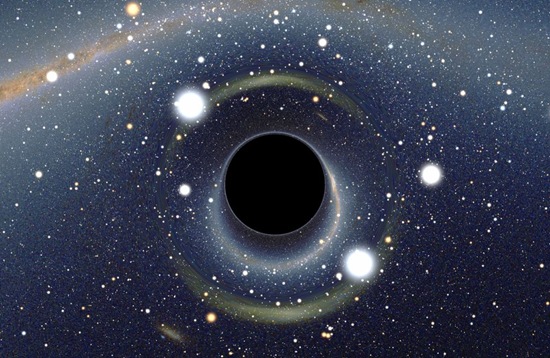
Black holes are gigantic cosmic monsters, exotic objects whose gravity is so strong that not even light can escape their clutches.
Black holes come in a wide variety of forms, from small stellar-mass bodies to the supermassive beasts that reside at the hearts of galaxies. Here are 10 of the most extreme black holes, from the smallest to the largest and from cannibals to rogues.
1. The Biggest Black Holes
This figure shows the immense size of the black hole discovered in the galaxy NGC 3842. NGC 3842, shown in the
background image, is the brightest galaxy in a rich cluster of galaxies. The black hole is at its centre and is
surrounded by stars (shown as an artist's concept in the central figure). The black hole is seven times larger
than Pluto's orbit. Our solar system (inset) would be dwarfed by it.
background image, is the brightest galaxy in a rich cluster of galaxies. The black hole is at its centre and is
surrounded by stars (shown as an artist's concept in the central figure). The black hole is seven times larger
than Pluto's orbit. Our solar system (inset) would be dwarfed by it.
Nearly all galaxies are thought to harbour at their cores supermassive black holes millions to billions of times the mass of our sun. Scientists recently discovered the largest black holes known in two nearby galaxies.
One of these galaxies, known as NGC 3842 - the brightest galaxy in the Leo cluster nearly 320 million light years away - has a central black hole containing 9.7 billion solar masses. The other, NGC 4889, the brightest galaxy in the Coma cluster more than 335 million light years away, has a black hole of comparable or larger mass.
The gravitational range, or "event horizon," of these black holes is about five times the distance from the sun to Pluto. For comparison, these black holes are 2,500 times as massive as the black hole at the centre of the Milky Way galaxy, whose event horizon is one-fifth the orbit of Mercury.
2. The Smallest Black Hole
The binary star system IGR J17091-3624 may contain the smallest black hole known. Scientists discovered it
by studying the heartbeat-like pattern of X-rays thought to be emitted from a disk of accreting matter around
the black hole.
by studying the heartbeat-like pattern of X-rays thought to be emitted from a disk of accreting matter around
the black hole.
The smallest black hole discovered to date may be less than three times the mass of our sun. This would put this little monster, officially called IGR J17091-3624, near the theoretical minimum limit needed for a black hole to be stable. As tiny as this black hole may be, it looks fierce, capable of 20 million mph winds (32 million kph) - the fastest yet observed from a stellar-mass black hole by nearly 10 times.
3. Cannibalistic Black Holes
The galaxy NGC3393 includes two active black holes (shown in inset) that are thought to result from the galaxy's
merger with a smaller companion.
merger with a smaller companion.
Black holes devour anything unlucky enough to drift too close, including other black holes. Scientists recently detected the monstrous black hole at the heart of one galaxy getting consumed by a still larger black hole in another.
The discovery is the first of its kind. Astronomers had witnessed the final stages of the merging of galaxies of equal mass - so-called major mergers - but minor mergers between galaxies and smaller companions had long eluded researchers.
Using NASA's Chandra X-ray Observatory, investigators detected two black holes at the centre of a galaxy dubbed NGC3393, with one black hole about 30 million times the mass of the sun and the other at least 1 million times the mass of the sun, separated from each other by only about 490 light-years.
4. Bullet-shooting Black Hole
The black hole's "belch" is actually a bipolar jet of plasma (ionized gas) that discharges particles from the centre of
an accretion disc (a structure that moves material toward its centre - in this case, the black hole). This galactic belch
ejects particles, scattering them amongst stars and planets, and may also affect magnetic fields in the galaxy.
an accretion disc (a structure that moves material toward its centre - in this case, the black hole). This galactic belch
ejects particles, scattering them amongst stars and planets, and may also affect magnetic fields in the galaxy.
Black holes are known for sucking in matter, but researchers find they can shoot it out as well. Observations of a black hole called H1743-322, which harbours five to 10 times the mass of the sun and is located about 28,000 light-years from Earth, revealed it apparently pulled matter off a companion star, then spat some of it back out as gigantic "bullets" of gas moving at nearly a quarter the speed of light.
5. The Oldest Known Black Hole
This artist's impression shows how ULAS J1120+0641, a very distant quasar powered by a black hole with a mass
2 billion times that of the sun, may have looked. This quasar is the most distant yet found and is also the brightest
object yet discovered in the early universe.
2 billion times that of the sun, may have looked. This quasar is the most distant yet found and is also the brightest
object yet discovered in the early universe.
The oldest black hole found yet, officially known as ULAS J1120+0641, was born about 770 million years after the Big Bang that created our universe. (Scientists think the Big Bang occurred about 13.7 billion years ago.)
The ancient age of this black hole actually poses some problems for astronomers. This brilliant enigma appears to be 2 billion times the mass of the sun. How black holes became so massive so soon after the Big Bang is difficult to explain.
6. The Brightest Black Hole
The nearby quasar 3C 273 is seen in a previous Hubble image (left) and a Hubble photo released in 2003 that reveals
internal details (right). In the right-most image, light from the central bright portion of the quasar has been blocked.
internal details (right). In the right-most image, light from the central bright portion of the quasar has been blocked.
Although the gravitational pulls of black holes are so strong that even light cannot escape, they also make up the heart of quasars, the most luminous, most powerful and most energetic objects in the universe.
As supermassive black holes at the centres of galaxies suck in surrounding gas and dust, they can spew out huge amounts of energy. The brightest quasar we see in the visible range is 3C 273, which lies about 3 billion light-years away.
7. Rogue Black Holes
This artist's conception shows a rogue black hole floating near a globular star cluster on the outskirts of the Milky Way.
When galaxies collide, black holes can get kicked away from the site of the crash to roam freely through space. The first known such rogue black hole, SDSSJ0927+2943, may be approximately 600 million times the mass of the sun and hurtle through space at a whopping 5.9 million mph (9.5 million kph). Hundreds of rogue black holes might wander the Milky Way.
8. Middleweight Black Holes
Swift X-ray observations of galaxy NGC 5408 indicate its ultraluminous X-ray source undergoes periodic changes
every 115.5 days. This cycle, astronomers suspect, is linked to the orbit of star circling a middleweight black hole,
donating mass to it.
every 115.5 days. This cycle, astronomers suspect, is linked to the orbit of star circling a middleweight black hole,
donating mass to it.
Scientists have long thought that black holes come in three sizes - essentially small, medium and large. Relatively small black holes holding the mass of a few suns are common, while supermassive black holes millions to billions of solar masses are thought to lurk at the heart of nearly every galaxy. One more massive than four million suns, for example, is thought to hide in the centre of the Milky Way.
However, middle-weight black holes had eluded astronomers for years. Scientists recently discovered an intermediate-mass black hole, called HLX-1 (Hyper-Luminous X-ray source 1), approximately 290 million light-years from Earth, which appears to be about 20,000 solar masses in size.
Medium-size black holes are thought to be the building blocks of supermassive black holes, so understanding more about them can shed light on how these monsters and the galaxies that surround them evolved.
9. Fastest-spinning Black Hole
This illustration shows a gas disk orbiting a black hole, with X-rays pouring out of the inner, white-shaded region.
For the non-spinning black hole (left), this inner radius is large. For the fast-spinning black hole (right), the gas can
orbit very near the event horizon, so the radius is much smaller.
For the non-spinning black hole (left), this inner radius is large. For the fast-spinning black hole (right), the gas can
orbit very near the event horizon, so the radius is much smaller.
Black holes can whirl the fabric of space around themselves at extraordinary speeds. One black hole called GRS 1915+105, in the constellation Aquila (The Eagle) about 35,000 light-years from Earth, is spinning more than 950 times per second.
An item placed on the edge of the black hole's event horizon - the edge past which nothing can escape - would spin around it at a speed of more than 333 million mph (536 million kph), or about half the speed of light.
10. Tabletop Black Holes
Scientists created an artificial event horizon of a black hole inside an optical fibre. Left: A micro-structured optical
fibre in which laser light is converted into a broad spectrum of visible light, or a "supercontinuum." This light is
partially leaking out of the fibre cladding. Right: Detail of the supercontinuum output from the microstructured fibre
dispersed by a prism and projected onto the screen. The picture shows that the supercontinuum contains all
colours of the rainbow.
fibre in which laser light is converted into a broad spectrum of visible light, or a "supercontinuum." This light is
partially leaking out of the fibre cladding. Right: Detail of the supercontinuum output from the microstructured fibre
dispersed by a prism and projected onto the screen. The picture shows that the supercontinuum contains all
colours of the rainbow.
Black holes are thankfully quite far away from Earth, but this distance makes it difficult to gather clues that could help solve the many mysteries that surround them. However, researchers are now recreating the enigmatic properties of black holes on tabletops.
For instance, black holes possess gravitational pulls so powerful that nothing, including light, can escape after falling past a border known as the event horizon. Scientists have created an artificial event horizon in the lab using fibre optics. They have also recreated the so-called Hawking radiation thought to escape from black holes.
Top image: Simulated view of a black hole in front of the Large Magellanic Cloud. Credit: Alain R./Wikimedia Commons.
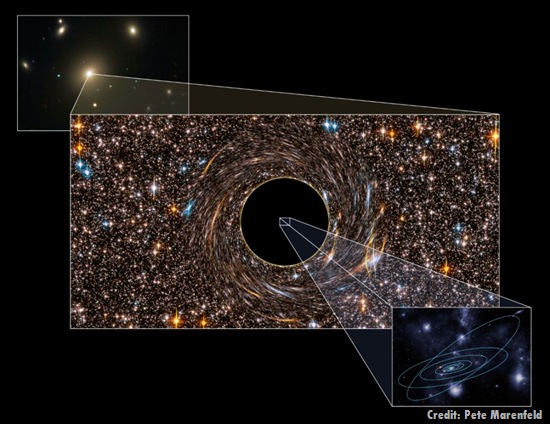
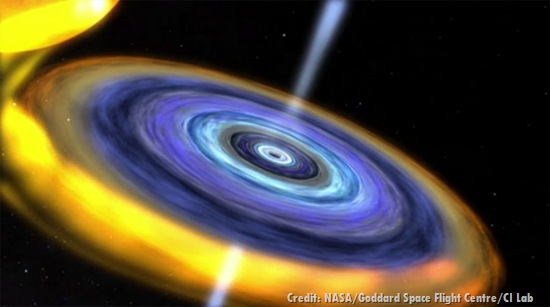

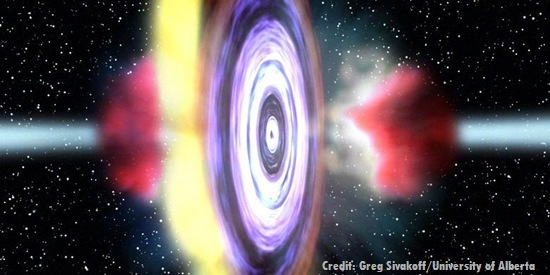
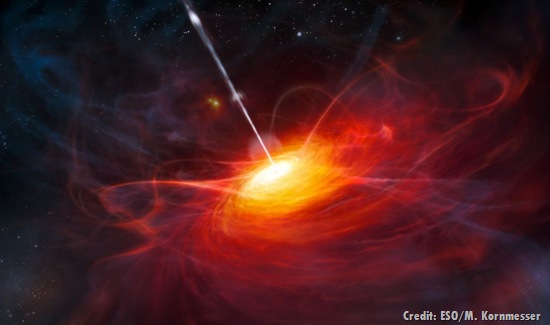
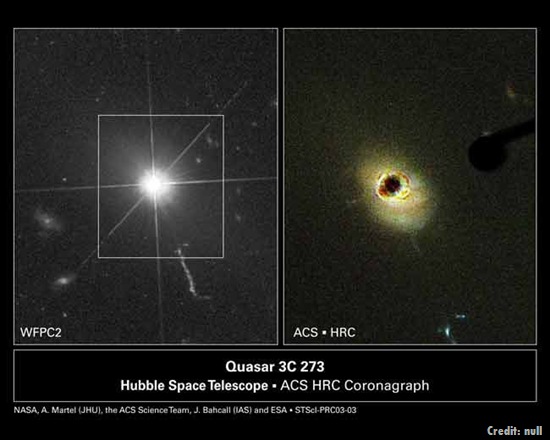
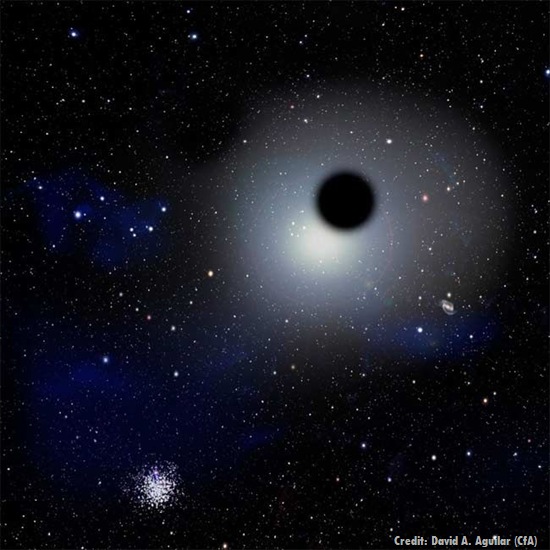
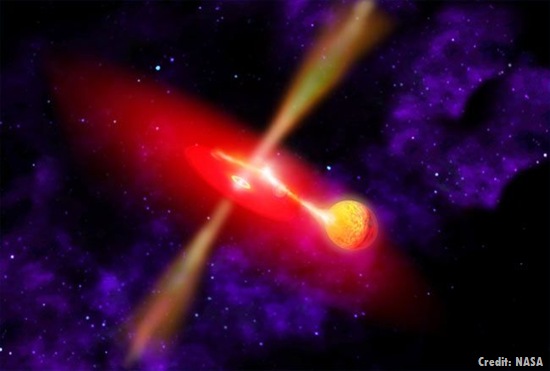

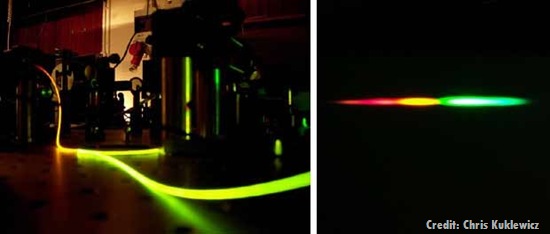
No comments:
Post a Comment
Please adhere to proper blog etiquette when posting your comments. This blog owner will exercise his absolution discretion in allowing or rejecting any comments that are deemed seditious, defamatory, libelous, racist, vulgar, insulting, and other remarks that exhibit similar characteristics. If you insist on using anonymous comments, please write your name or other IDs at the end of your message.